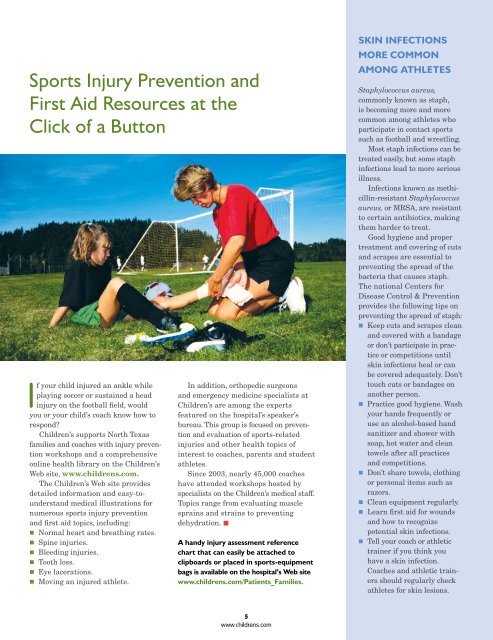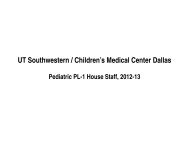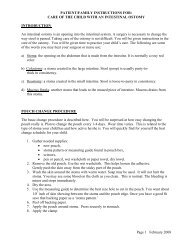NIGhtmAReS vS. SleeP teRRoRS cAR SeAt SAfety SPoRtS ...
NIGhtmAReS vS. SleeP teRRoRS cAR SeAt SAfety SPoRtS ...
NIGhtmAReS vS. SleeP teRRoRS cAR SeAt SAfety SPoRtS ...
You also want an ePaper? Increase the reach of your titles
YUMPU automatically turns print PDFs into web optimized ePapers that Google loves.
Sports injury prevention and<br />
first aid resources at the<br />
click of a Button<br />
if your child injured an ankle while<br />
playing soccer or sustained a head<br />
injury on the football field, would<br />
you or your child’s coach know how to<br />
respond?<br />
Children’s supports North Texas<br />
families and coaches with injury prevention<br />
workshops and a comprehensive<br />
online health library on the Children’s<br />
Web site, www.childrens.com.<br />
The Children’s Web site provides<br />
detailed information and easy-tounderstand<br />
medical illustrations for<br />
numerous sports injury prevention<br />
and first aid topics, including:<br />
n Normal heart and breathing rates.<br />
n Spine injuries.<br />
n Bleeding injuries.<br />
n Tooth loss.<br />
n Eye lacerations.<br />
n Moving an injured athlete.<br />
In addition, orthopedic surgeons<br />
and emergency medicine specialists at<br />
Children’s are among the experts<br />
featured on the hospital’s speaker’s<br />
bureau. This group is focused on prevention<br />
and evaluation of sports-related<br />
injuries and other health topics of<br />
interest to coaches, parents and student<br />
athletes.<br />
Since 2003, nearly 45,000 coaches<br />
have attended workshops hosted by<br />
specialists on the Children’s medical staff.<br />
Topics range from evaluating muscle<br />
sprains and strains to preventing<br />
dehydration. n<br />
A handy injury assessment reference<br />
chart that can easily be attached to<br />
clipboards or placed in sports-equipment<br />
bags is available on the hospital’s web site<br />
www.childrens.com/Patients_families.<br />
5<br />
www.childrens.com<br />
SKIN INfectIoNS<br />
moRe commoN<br />
AmoNG AthleteS<br />
Staphylococcus aureus,<br />
commonly known as staph,<br />
is becoming more and more<br />
common among athletes who<br />
participate in contact sports<br />
such as football and wrestling.<br />
Most staph infections can be<br />
treated easily, but some staph<br />
infections lead to more serious<br />
illness.<br />
Infections known as methicillin-resistant<br />
Staphylococcus<br />
aureus, or MRSA, are resistant<br />
to certain antibiotics, making<br />
them harder to treat.<br />
Good hygiene and proper<br />
treatment and covering of cuts<br />
and scrapes are essential to<br />
preventing the spread of the<br />
bacteria that causes staph.<br />
The national Centers for<br />
Disease Control & Prevention<br />
provides the following tips on<br />
preventing the spread of staph:<br />
n Keep cuts and scrapes clean<br />
and covered with a bandage<br />
or don’t participate in practice<br />
or competitions until<br />
skin infections heal or can<br />
be covered adequately. Don’t<br />
touch cuts or bandages on<br />
another person.<br />
n Practice good hygiene. Wash<br />
your hands frequently or<br />
use an alcohol-based hand<br />
sanitizer and shower with<br />
soap, hot water and clean<br />
towels after all practices<br />
and competitions.<br />
n Don’t share towels, clothing<br />
or personal items such as<br />
razors.<br />
n Clean equipment regularly.<br />
n Learn first aid for wounds<br />
and how to recognize<br />
potential skin infections.<br />
n Tell your coach or athletic<br />
trainer if you think you<br />
have a skin infection.<br />
Coaches and athletic trainers<br />
should regularly check<br />
athletes for skin lesions.








